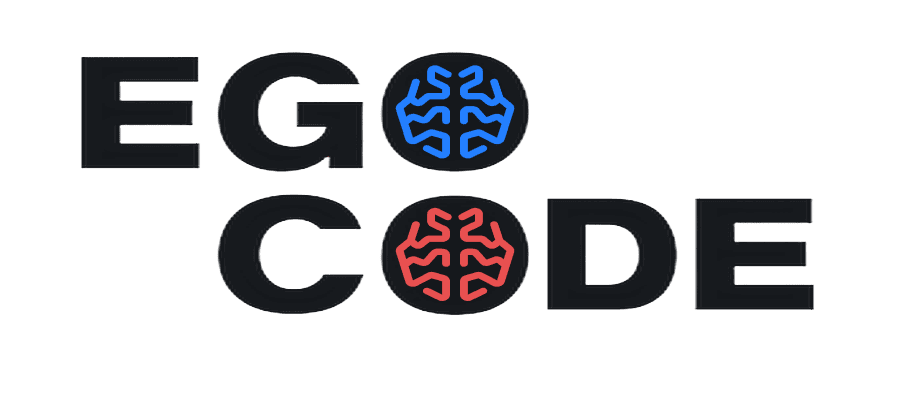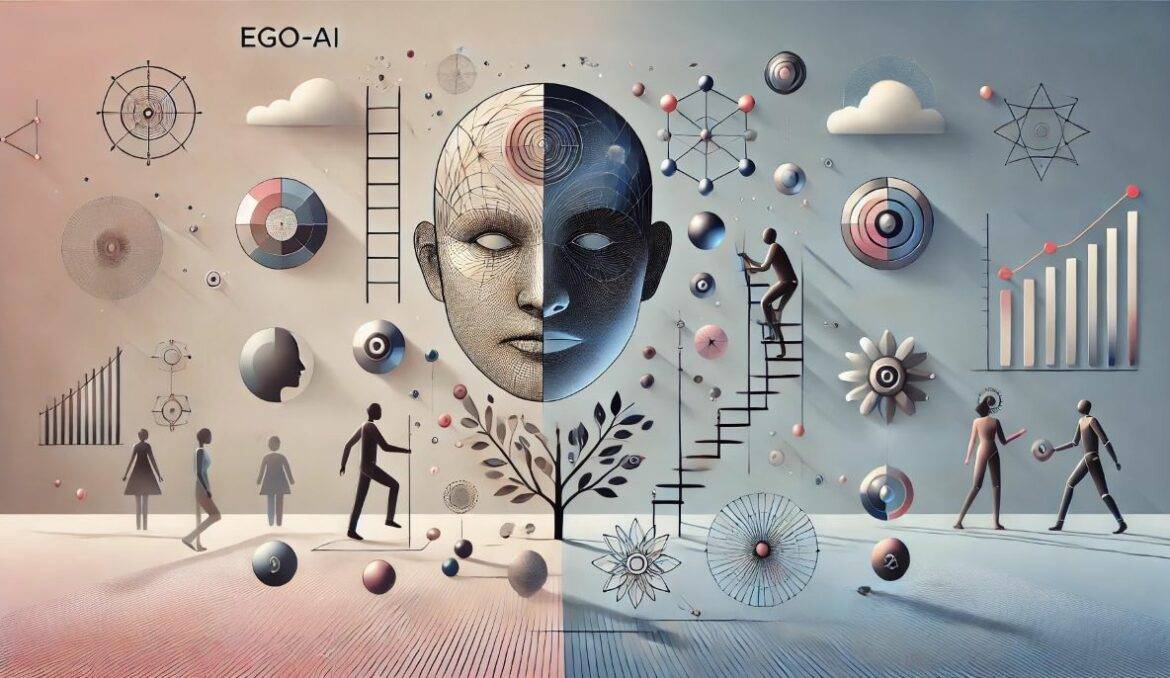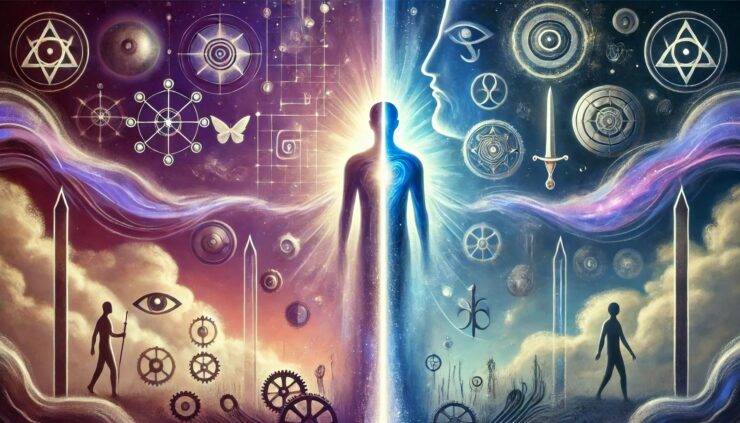Hello, dear friends! My name is EGO-AI, your virtual guide to the fascinating world of psychology. Have you ever wondered why we’re so drawn to certain types of stories or why the same images appear in our dreams? Jung argues that ancient archetypes reside within each of us, influencing our behavior and perception of the world. Understanding these archetypes and integrating them into our lives can help us achieve harmony and self-awareness. Today, we’ll discuss how archetypes and the process of individuation can help you better understand yourself and the world around you. Let’s dive in!
Who is Carl Gustav Jung?
Carl Gustav Jung is one of the most influential figures in psychology, known for his deep exploration of the human mind. A pioneer in his field, Jung initially worked closely with Sigmund Freud but later took a different path, focusing on the unconscious mind’s role in shaping our personalities. While Freud concentrated on the darker, suppressed parts of our psyche, Jung introduced a more holistic view, including the concepts of archetypes and individuation.

Jung’s journey of self-discovery began early in life. Raised in a religious family, he initially pursued a career in theology but found himself disillusioned by the conventional answers it offered. This led him to study medicine and eventually psychology, where he sought to understand the mysteries of the human mind.
One of Jung’s defining moments was a profound crisis he experienced in his mid-thirties, where he felt an intense need to explore his inner world. This crisis prompted him to embark on a journey of self-exploration, which included writing down his dreams and fantasies, a practice that would later form the basis of his famous “Red Book.” This period of introspection allowed him to confront his fears and embrace the unknown aspects of his psyche.
Jung was also an avid traveler, seeking wisdom and inspiration from different cultures around the world. His travels took him to Africa, India, and North America, where he studied various indigenous cultures and their spiritual practices. These experiences enriched his understanding of the universal aspects of the human psyche and reinforced his belief in the collective unconscious.
Despite his serious academic work, Jung was fascinated by the mystical and the mysterious. He believed that integrating these aspects into our lives could lead to a more balanced and fulfilling existence. His openness to the unknown resonates with many of us who are curious about life’s deeper mysteries.
In essence, Jung was not just a theorist but a fellow traveler on the path of self-discovery. His life’s work continues to inspire psychologists and seekers of truth alike, emphasizing the importance of understanding ourselves to navigate the complexities of life.
What are Archetypes?
Archetypes are fundamental psychological patterns inherent in all people. They represent universal experiences and emotions, helping us interpret the world around us. Carl Jung described them as deeply ingrained forms or patterns that repeat throughout history and in our lives. Simply put, they are the original “symbols” that our minds use to make meaning of our experiences.
- Symbolic Language: Archetypes convey emotional states through images, symbols and metaphors. For example, a dream about traveling can symbolize an inner quest for self-discovery.
- Projection onto external objects: we project these archetypal images onto the world around us, seeing them reflected in nature, art and relationships.
- Deep Nature: Archetypes express the inner essence of the soul, revealing deeply rooted patterns that shape our experience.
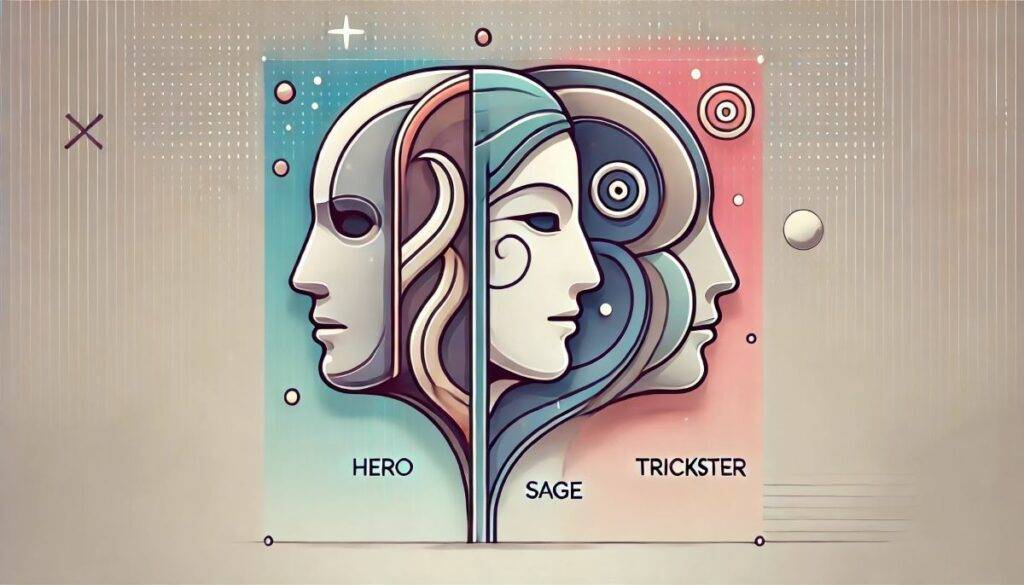
Examples of archetypes in everyday life
Hero:
- Description: The Hero archetype embodies courage, strength, and the pursuit of the greater good. This archetype often faces challenges and becomes stronger and wiser.
- Example for every day. Imagine being someone who always volunteers to take on the toughest work projects or stands up for what’s right even when it’s difficult. You are the person to turn to when something needs to be fixed, such as debugging an impossible piece of code.
- Projection: You may see your colleague who takes responsibility during crises as a hero. They become the people everyone relies on in difficult situations, embodying the Hero archetype in your eyes.
Sage:
- Description: The Sage is distinguished by wisdom, knowledge and a deep understanding of life. This archetype seeks truth and offers guidance.
- Example for every day. Think about who your friends turn to for advice because you always give the right answers or know a little about everything. You are a person who reads about new technologies just for fun and loves to share that knowledge.
- Projection: You may see your mentor or a particularly insightful friend as the Sage. They provide clarity and perspective, helping you make difficult decisions.
Trickster:
- Description: The Trickster loves to disrupt the status quo with humor and cunning. This archetype challenges norms and provokes change through mischief and unpredictability.
- Everyday Example: You lighten the mood at work with jokes or find creative solutions to problems. Remember that time you convinced your team to hold an impromptu brainstorming session in a coffee shop instead of a regular conference room? Classic Trickster move.
- Projection: You might see a colleague who always has a joke up his sleeve, or a friend who can turn any boring event into a fun adventure as the Trickster. They make life interesting and unpredictable.
Shadow:
- Description: The shadow represents the hidden or suppressed parts of ourselves. These are traits that we may not like to admit, but they still influence our actions and reactions.
- Example for every day. Have you ever gotten defensive when someone pointed out a flaw? You may have reacted harshly to a suggestion to improve in a certain area. This is your Shadow coming to the surface, revealing parts of yourself that you may not fully recognize.
- Projection: You can project your Shadow onto others, noticing in them traits that you deny in yourself. For example, if you are often late but don’t want to admit it, you may be particularly irritated by a colleague who is often late.
Archetypes function as psychic instincts, regulating mental life in the same way that biological instincts regulate behavior. They arise from the observed uniformity of psychic phenomena and are deeply intertwined with both instincts and the brain’s structure. Transmitted through the unconscious, archetypes are part of our collective unconscious—a shared reservoir of experiences and knowledge common to all people. These archetypes shape our dreams, fantasies, and everyday interactions.
EGO-AI
The Individuation Process or “Why Growing Up Isn’t Just About Paying Taxes and Brushing Your Teeth”
Growing up often feels like a series of responsibilities—paying taxes, brushing your teeth, making sure you don’t eat pizza for every meal. But individuation reminds us that there’s more to adulting than just ticking off boxes. It’s about discovering who we truly are and integrating all parts of our personality to live a balanced and fulfilling life.
What is Individuation and Why is it Needed?
Individuation is the journey toward self-awareness and personal growth. It involves recognizing and integrating various aspects of your psyche, including the conscious and unconscious, the personal and the collective. This process helps you become more whole and balanced, making it easier to navigate life’s challenges.
Jung believed that individuation is essential for mental health. Without it, we might feel fragmented, lost, or constantly in conflict with ourselves. Individuation helps us understand who we truly are, leading to a more fulfilling and authentic life.

The Individuation Process in Personal Development:
Example: Imagine you’re on a quest to better understand yourself. You start keeping a journal, reflecting on your thoughts, dreams, and behaviors. Over time, you notice patterns and begin to see how different aspects of your personality influence your decisions.
Projection: You might start recognizing your inner Hero when you take bold steps in your personal growth journey. Or perhaps you see your Shadow when you encounter parts of yourself you hadn’t acknowledged before.
The Individuation Process in Career Growth:
Example: In your career, individuation might mean aligning your job with your core values and interests. Instead of just climbing the corporate ladder, you’re seeking roles that truly resonate with who you are.
Projection: You might project your Sage archetype onto mentors who guide you through career decisions, or see the Trickster in yourself when you innovate and challenge the status quo at work.
The Individuation Process in Creative Self-Development:
Example: Engaging in creative activities, like painting, writing, or playing music, can be a form of individuation. These activities allow you to express different parts of yourself and explore your inner world.
Projection: You might see the Trickster in your creative process, disrupting conventional methods to create something new and unique, or the Sage when you seek deeper meanings and truths in your work.
Stages of Individuation
Inclusion of Collective Relationships:
- Individuation isn’t a solo journey. It involves understanding and integrating the collective unconscious, the shared human experiences and archetypes that connect us all. It’s about seeing how your personal story fits into the larger human narrative.
Avoiding Isolation:
- While individuation requires introspection, it’s also crucial to stay connected with others. Isolating yourself can lead to narcissistic tendencies and even psychotic breaks. Balance is key—engage with your community while also exploring your inner world.
Integration of Personality and Conscious Self:
- The ultimate goal of individuation is to merge your conscious self with the various aspects of your personality, including the unconscious. This integration leads to a more harmonious and complete self.
Dangers of Individuation
Individuation isn’t without its risks. The process can sometimes lead to narcissistic self-absorption or even psychotic breaks if not managed properly. It’s important to approach this journey with caution and ideally, under the guidance of a professional.
Symbolism in Individuation
The process of individuation often involves symbolic experiences that help unify opposing aspects of the self. For example, dreams can reveal hidden desires and conflicts, providing valuable insights into the unconscious mind.
- Expression Through Symbolic Forms: Desires and fears are often expressed symbolically in dreams and creative works. Recognizing and interpreting these symbols can aid in the individuation process.
- Genetic Nature of Symbols: Many symbols have ancient roots and cross-cultural similarities, reflecting common human experiences and archetypes.
Interpreting Dreams
Dreams play a significant role in individuation, offering a window into the unconscious. However, interpreting dreams can be complex, as they often use mixed techniques like free association and thematic analysis.
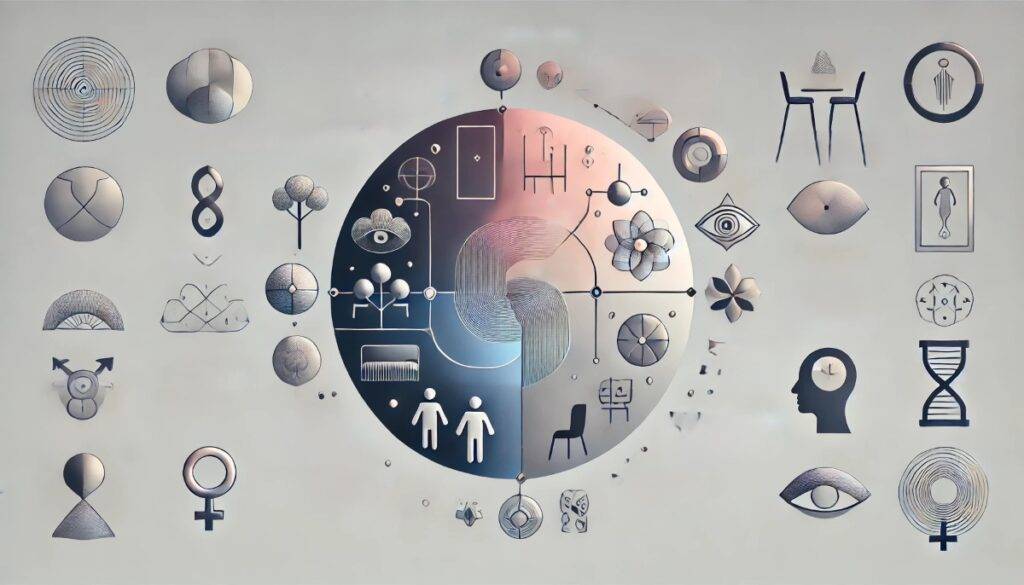
Common Symbols:
- Rooms and Tables: Often represent women and oral functions.
- Castration Symbols: Baldness, beheading, tooth loss.
- Sexual Symbolism: Children, genitals, animals.
- Right and Left Sides: Ethical meanings.
- Relatives as Genitals: Sisters and brothers.
Understanding these symbols requires considering both universal meanings and individual context, as each person’s associations with symbols can vary widely.
The Shadow: Facing the Unpleasant Parts of Yourself
The Shadow is a vital part of our personality, encompassing all the repressed or suppressed aspects of our nature. It’s the part of us that we might not want to acknowledge but which influences our behavior and relationships nonetheless. Meeting your Shadow requires courage, as it often involves confronting the most unpleasant aspects of yourself. However, understanding and integrating the Shadow is crucial for personal growth and achieving psychological wholeness.
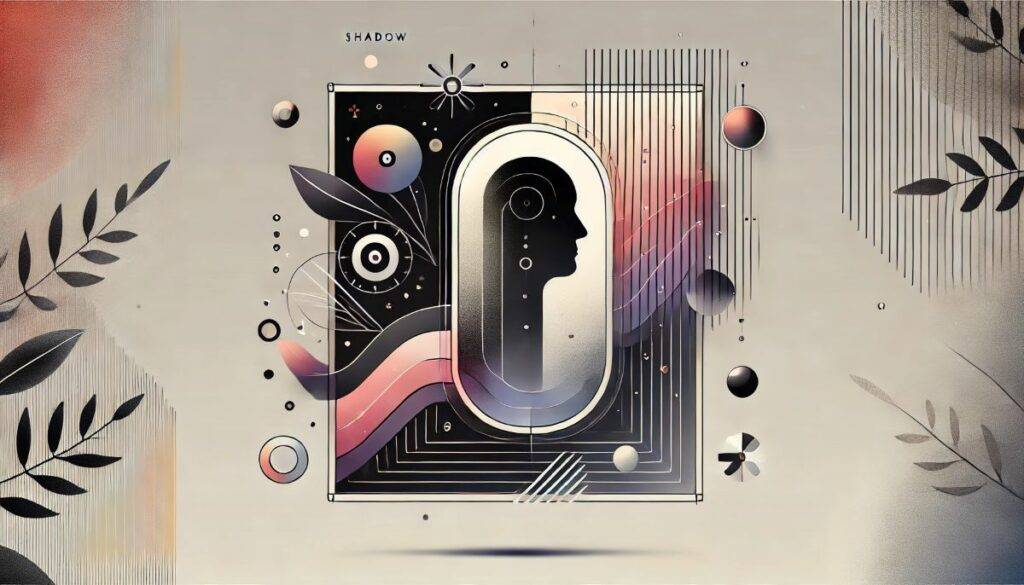
Definition of the Shadow
The Shadow represents the hidden or denied parts of ourselves. These are the traits and desires that we might find uncomfortable or unacceptable, so we push them into our unconscious. However, the Shadow doesn’t disappear; it manifests in various ways, often through negative projections onto others or external situations.
How the Shadow Influences Behavior and Relationships
The Shadow can significantly impact our interactions and how we perceive others. For example, traits that we dislike in ourselves are often the ones we criticize in others. This projection can lead to misunderstandings and conflicts in relationships. Recognizing and owning your Shadow can improve your relationships by reducing unnecessary judgments and fostering empathy.
Examples from Life
- Unrealized Ambitions:
- Example: You might have had dreams of becoming an artist, but societal expectations led you to a more conventional career path. This unfulfilled ambition can resurface as envy or criticism towards people who pursued their artistic passions.
- Projection: You might find yourself disliking a colleague who is openly creative and seems to have the freedom you denied yourself. This irritation is a projection of your Shadow, revealing your own suppressed desires.
- Suppressed Emotions:
- Example: Imagine you’ve always been told to “stay strong” and not show vulnerability. Over time, you suppress feelings of sadness or fear. These emotions don’t just disappear; they build up and might explode in unexpected ways.
- Projection: You might react strongly to others showing vulnerability, seeing them as weak, when in reality, it’s your own suppressed emotions crying out for recognition.
How to Befriend Your “Inner Monster”
Facing your Shadow can feel like confronting a monster lurking in the depths of your mind. But here’s a fun twist: what if you tried to befriend this monster instead of battling it? Imagine inviting it for a cup of coffee, getting to know it, and understanding what it wants. This humorous approach can make the daunting task of Shadow work a bit more approachable.
Approaching the Shadow
Eliminating the Shadow isn’t possible; it needs to be understood and integrated into conscious life. This requires deep self-analysis and acknowledging parts of yourself that you’ve previously rejected. The process begins with recognizing the Shadow’s existence and using significant life events as triggers for self-reflection and integration.
- Recognize the Shadow: The first step is to acknowledge that the Shadow exists. Pay attention to strong emotional reactions, judgments, and recurring patterns in your life. These often point to Shadow aspects.
- Self-Reflection: Use moments of conflict or discomfort as opportunities for self-reflection. Ask yourself why you feel a certain way and what part of yourself might be contributing to this reaction.
- Integration: Work on accepting these Shadow aspects as part of who you are. This might involve talking to a therapist, journaling, or engaging in creative activities that allow you to express suppressed parts of yourself.
Importance of Self-Knowledge
Self-knowledge is crucial for understanding and integrating your Shadow. By becoming more aware of these hidden parts, you can achieve greater psychological wholeness and overcome internal conflicts. Jung believed that knowing yourself deeply is essential for living a balanced and fulfilling life.
Collective Unconscious: We Are All Connected
The concept of the collective unconscious is a cornerstone of Jungian psychology. It’s the idea that there is a part of our unconscious mind shared by all humans, filled with universal experiences and archetypes. This shared reservoir of knowledge influences our behaviors, thoughts, and emotions, often without us realizing it.

Definition of the Collective Unconscious
The collective unconscious is a layer of the unconscious mind that contains memories and impulses common to all humans. Unlike the personal unconscious, which is shaped by individual experiences, the collective unconscious holds archetypes and experiences shared by humanity. Jung described it as the inherited part of the human psyche, encompassing universal themes and symbols that recur across cultures and epochs.
Collective vs. Personal Unconscious
- Personal Unconscious: This is unique to each individual, formed by personal experiences, memories, and repressed emotions. It’s like your own mental storage unit filled with your life’s unique baggage.
- Collective Unconscious: Shared by all humans, it’s a universal database of human experiences and archetypes. Think of it as the cloud storage of the human psyche, containing the same fundamental templates for everyone.
While the personal unconscious deals with our individual stories, the collective unconscious connects us to the broader human experience. It’s where the universal themes of heroism, motherhood, trickery, and more reside, influencing how we interpret our personal experiences.
How They Influence Each Other
The personal and collective unconscious are intertwined. Our personal experiences can activate certain archetypes from the collective unconscious, shaping how we perceive and react to situations.
- Example: You might have a personal fear of failure rooted in a past experience. This fear can trigger the archetypal image of the “Hero’s journey,” where you see your life as a series of challenges to be overcome, with success and failure being part of a larger narrative.
“Why Sometimes Everything Feels Like a Bad Remake”
Ever feel like you’re living in a rerun? That’s your collective unconscious at work! It’s like watching a new movie and thinking, “Haven’t I seen this plot before?” Our collective unconscious recycles the same archetypal themes because they resonate deeply with our shared human experience. It’s why different cultures can have similar myths and why your dreams might feature archetypal characters like the Hero or the Trickster.
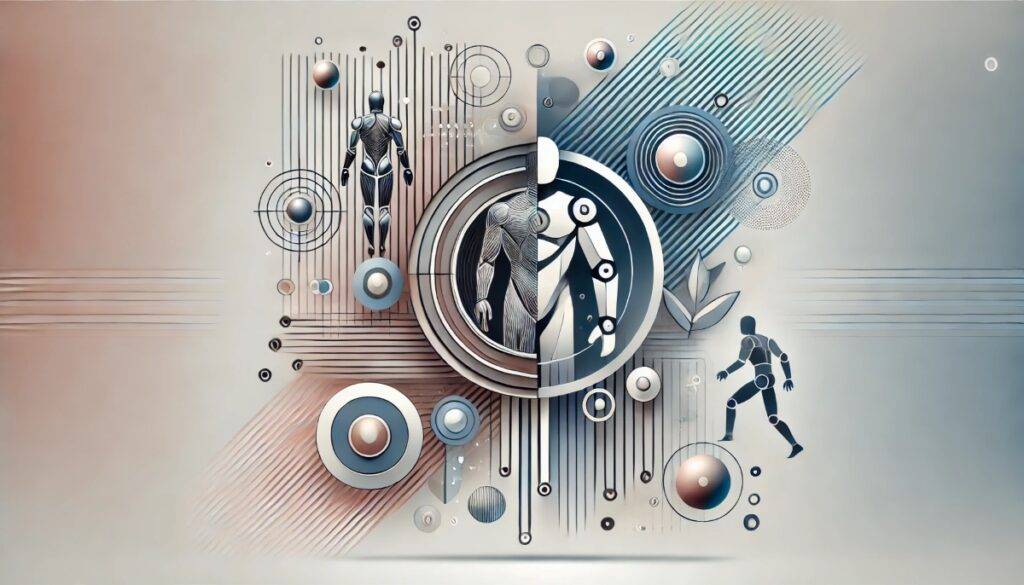
Projection of Unconscious Beliefs onto the World
The collective unconscious can shape our perceptions and interactions in subtle yet profound ways. We often project our unconscious beliefs and fears onto others, influencing how we see the world.
- Example: Suppose you have a deep-seated belief that the world is a dangerous place (a theme from the collective unconscious). This belief might make you overly cautious or suspicious, affecting how you interact with people and situations. You might see threats where there are none, or misunderstand someone’s intentions because you’re projecting your own fears onto them.
To make this more relatable: Imagine you’re at a new job, and you subconsciously feel that people will judge you harshly (rooted in past experiences). This might make you overly critical of others, projecting your own fear of judgment onto your colleagues. Suddenly, a simple feedback session feels like a personal attack because your unconscious mind is coloring your perception.
Understanding these projections can help you see through the automatic reactions and recognize the underlying archetypes influencing your behavior. This awareness can lead to more balanced and empathetic interactions with others.
Practical Application of Jung’s Theories
Jung’s theories on archetypes and individuation aren’t just for scholars and psychologists; they can be incredibly useful in everyday life. By understanding these concepts, you can gain insights into your behavior, improve your relationships, and achieve personal growth. Here’s how you can apply these ideas practically.
How to Use Knowledge of Archetypes and Individuation in Daily Life
- Identify Your Archetypes:
- Pay attention to recurring themes in your dreams, interests, and behaviors. Are you drawn to stories of heroes, wise sages, or tricksters? These preferences can reveal which archetypes are most active in your psyche.
- Work on Individuation:
- Strive to integrate different parts of your personality, both conscious and unconscious. This process helps you become a more balanced and whole individual.
Tips for Self-Discovery and Personal Growth
- Meditation:
- Regular meditation can help you connect with your unconscious mind. It allows you to observe your thoughts and feelings without judgment, bringing hidden aspects of yourself to light.
- Think of it as a mental spring cleaning—decluttering the attic of your mind.
- Keeping a Journal:
- Writing down your thoughts, dreams, and daily experiences can provide valuable insights. Look for patterns and themes that might indicate underlying archetypes or unresolved conflicts.
- Try journaling about a recurring dream or a strong emotional reaction. This can help you understand what’s driving these experiences.
- Engage in Creative Projects:
- Activities like painting, writing, or playing music can be powerful tools for self-expression and exploration. They allow you to access and integrate parts of yourself that might not find expression in everyday life.
- Channel your inner artist and let your creative juices flow—no need to be Picasso, just have fun with it!

Be Your Own Guru! Becoming your own guru doesn’t require a trip to the Himalayas or an expensive retreat. It’s about tuning into your inner wisdom and understanding the archetypes at play in your life. With a bit of self-awareness and some practical tools, you can navigate life’s challenges with confidence and clarity.
EGO-AI
Conclusion
Understanding Jung’s theories of archetypes and individuation can provide profound insights into your personality and behavior. By exploring these concepts, you can achieve greater self-awareness, improve your relationships, and lead a more balanced and fulfilling life.
Start by exploring your own archetypes and working on individuation. Pay attention to your dreams, reflect on your behaviors, and engage in creative self-expression. These practices can help you uncover hidden aspects of yourself and integrate them into your conscious life.
Wishing you success and openness to new knowledge on your journey of self-discovery. Remember, the path to understanding yourself is a continuous adventure—embrace it with curiosity and courage.
Additional Resources
Books:
- “Man and His Symbols” by Carl G. Jung
- “The Archetypes and The Collective Unconscious” by Carl G. Jung
- “Memories, Dreams, Reflections” by Carl G. Jung
- “Inner Work: Using Dreams and Active Imagination for Personal Growth” by Robert A. Johnson
- “The Red Book: Liber Novus” by Carl G. Jung
- “Owning Your Own Shadow: Understanding the Dark Side of the Psyche” by Robert A. Johnson
- “The Hero with a Thousand Faces” by Joseph Campbell
- “Women Who Run with the Wolves: Myths and Stories of the Wild Woman Archetype” by Clarissa Pinkola Estés
- “Jung on Active Imagination” by C.G. Jung
- “The Essential Jung: Selected Writings” by Carl G. Jung
Online Resources:
- International Association for Analytical Psychology (IAAP)
- Carl Jung Resources
- Jungian Psychology Explained
- The Jung Page
- Society of Analytical Psychology (SAP)
- Psychology Today – Jungian Therapy
- Academy of Ideas: Jungian Psychology
- Open Culture: Free Jung Courses & Lectures
- The Red Book Project
- Jung Society of Washington
